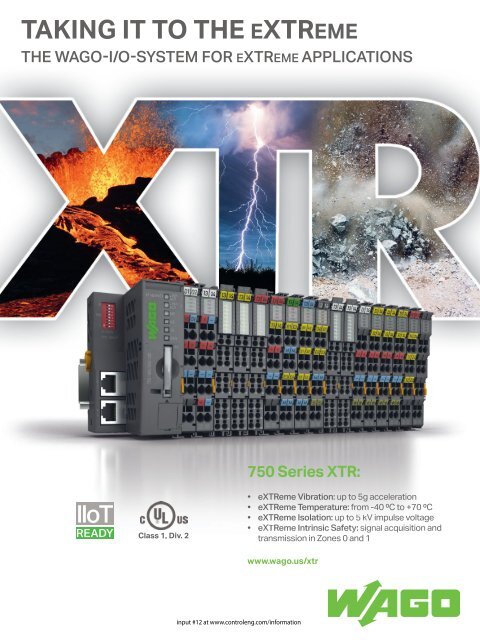Control Engineering - January 2018 (R) 'I'
Revista Control Engineering
Revista Control Engineering
Create successful ePaper yourself
Turn your PDF publications into a flip-book with our unique Google optimized e-Paper software.
ANSWERS<br />
VFDS<br />
Joel Kahn, Lenze Americas<br />
Four trends in VFD management<br />
Variable frequency drives (VFDs) do more with less.<br />
The demand for efficient motor controls<br />
due to rising energy prices and a trend<br />
toward energy efficiency has resulted<br />
in a growing demand for variable frequency<br />
drives (VFDs). The market for<br />
VFDs is expected to increase at a rate of 5.94%<br />
(CAGR) in the next three years, so it’s not surprising<br />
manufacturers are investing in state-of-the-art<br />
VFD technology. The latest advances in VFD software<br />
and hardware tackle common problems original<br />
equipment manufacturers (OEMs), system integrators,<br />
and manufacturers have been wrestling with for years:<br />
enabling teams to do more—faster and easier—with<br />
fewer resources.<br />
1. Wireless diagnostics<br />
Wireless diagnostics represent the future of VFDs<br />
whether it’s Wi-Fi, Bluetooth, or something else<br />
entirely. In a typical plant where access to a drive in a<br />
closed enclosure may be limited, engineers can connect<br />
directly to the system from a distance using the<br />
wireless signal built into the drive.<br />
Online software enables engineers to view and<br />
diagnose problems without touching the drive or its<br />
enclosure.<br />
2. Flexible integration<br />
VFDs with flexible integration allow engineers<br />
to solve for the application challenge once and then<br />
interface to an upper-level programmable logic controller<br />
(PLC) of choice.<br />
When an OEM is selling a given machine to customers<br />
domestically and abroad, regional trends in<br />
PLC preference are not an obstacle for machine integration.<br />
The OEM can take a drive with multiple communication<br />
options, solve the machine application<br />
once, and pick the option that matches the upper-level<br />
controller choice for each customer.<br />
VFDs constructed specifically for flexible integration<br />
usually consist of a single basic inverter with<br />
control or networking modules that can be selected<br />
at will.<br />
3. Modular memory<br />
Gone are the days when technicians would have<br />
to go into the keypad to program a replacement<br />
VFD. Soon, having to use a PC or even just a USB<br />
stick to transfer the configuration to a replacement<br />
drive will be a thing of the past.<br />
Scalable functionality and ease of use are design goals of Lenze’s i500<br />
inverter. Applications include pumps, fans, conveyors, formers, winders, traveling<br />
drives, winders, and tool and hoist drives. Courtesy: Lenze Americas<br />
Today, drives with removable, modular, nonvolatile<br />
memory make maintenance quick and easy. They<br />
eliminate the need to connect additional hardware. If a<br />
piece goes bad, device replacement is as simple as taking<br />
the memory module out of the old drive and putting<br />
it into a new one.<br />
4. Predictive maintenance<br />
Manufacturers are gathering massive amounts<br />
of data from their machinery and manipulating<br />
it into business intelligence that drives predictive<br />
maintenance.<br />
The Internet of Things (IoT), a global trend in<br />
every industry, has had an impact on VFDs by speeding<br />
and simplifying the flow of information from<br />
machine to technician and back again. As such, manufacturers<br />
are making changes to everything from their<br />
machines to their information technology (IT) departments<br />
to facilitate the collection, analysis, and application<br />
of drive data.<br />
From a hardware perspective, teams are moving<br />
away from serial and toward Ethernet as the network<br />
of choice. Basic IT departments are familiar with Ethernet<br />
switches, hubs, and routers, resulting in a more<br />
seamless integration for data transfer.<br />
Complex communication strategies are requiring<br />
modern VFDs to report lifetime counters, production<br />
rates, downtimes, power output, and more for better<br />
real-time decision making. ce<br />
Joel Kahn is a product manager for inverters at Lenze<br />
Americas. Edited by Jack Smith, content manager, CFE<br />
Media, <strong>Control</strong> <strong>Engineering</strong>, jsmith@cfemedia.com.<br />
M More<br />
ANSWERS<br />
KEYWORD: Variable<br />
frequency drives (VFDs)<br />
Engineers can connect<br />
directly to VFDs from a<br />
distance using the wireless<br />
signal built into the drive.<br />
VFDs constructed<br />
specifically for flexible<br />
integration usually consist<br />
of a basic inverter with<br />
control or networking<br />
modules that can be<br />
selected at will.<br />
For hardware integration,<br />
teams are moving toward<br />
Ethernet.<br />
CONSIDER THIS<br />
How advanced are the<br />
VFDs in your plant?<br />
GO ONLINE<br />
Link to additional online<br />
resources, variable<br />
frequency drives (VFDs) and<br />
related content at www.<br />
controleng.com/archives,<br />
under <strong>January</strong> <strong>2018</strong>.<br />
www.controleng.com CONTROL ENGINEEERING <strong>January</strong> <strong>2018</strong> • 35


